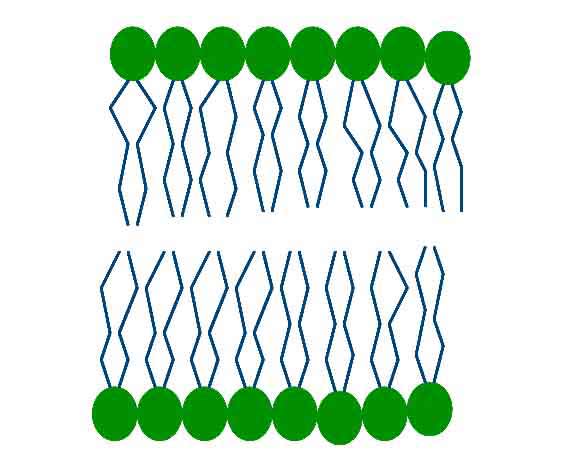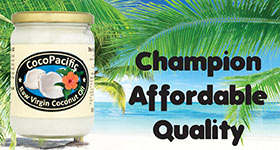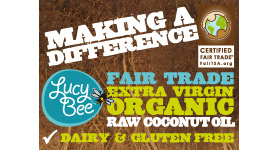|
|
|
|
Some people avoid eating the skin on the chicken. They say it is full of fat, and to be avoided. Sometimes they also say their skin is dry and itchy. This is because our skin needs fat too. Skin and other membranes are made of fats, or rather phospholipids, and proteins. Lipids just means fats and oils. A phospholipid is phosphate (shown in green) stuck on the end of two fatty acids (in blue).
These phospholipids form a double layer, which acts as a barrier.
Proteins are embedded in this double layer, and chains of sugars. The skin protects us from infection and nasty chemicals. Cell membranes keep the contents of the cells inside, and protect the cells from the outside. The proteins control what comes in and out of the cell. The cells contain mitochondria, where energy is made, and these have membranes round them too. Mitochondrial membranes are rich in protein, while myelin, the insulator for nervous system cells, is rich in fats. Without insulation, someone suffers from multiple sclerosis. The lining of the gut is also made of phospholipids. Without enough fat, the skin becomes dry and itchy. Eczema, dermatitis or dandruff may occur. Without fat, the gut wall becomes leaky, so that fragments of food enter the bloodstream before they have been fully broken down. They may then circulate round the body, causing allergies, inflammation, and anaphylaxis. If the barrier between the blood and the brain is leaky, harmful chemicals may affect the brain, causing insomnia, hyperactivity, a lack of empathy, delusions and hallucinations. The fatty acids don’t all look the same. They may be long or short, straight or bended. Saturated fats, like stearic acid in meat, butyric acid in butter, palmitic acid in nuts, and myristic and lauric acid in coconut, are straight. They fit together neatly, making solid fats. The fats in butter and coconut are involved in keeping the gut wall intact. Monounsaturated fats, like oleic acid in olives, have one bend. Polyunsaturates have more than one bend. Because they have bends in them, they do not pack together neatly. They are free to move about, making oils runny. The bends in fats give membranes suppleness. Suppleness is one thing, but we do not want membranes to be too floppy. Cholesterol is useful, as it prevents floppiness. Solid fats are safer for frying than runny oils, as toxic chemicals are produced by frying oils. When many meals are fried in the same fat, it becomes more harmful. Hydrogenated fats, in solid margarine, solid white vegetable fat, and many factory-produced foods, are twisted and dangerous. Such fats are often found in crisps and biscuits. Rancid fats that have been kept in a warm kitchen instead of the fridge are also harmful. There are two kinds of essential polyunsaturated fats that control inflammation and clotting. Their families are called omega three and omega six. If we eat flax seeds, hemp seeds or walnuts, they provide us with alpha linolenic acid (ALA), which protects us from cancer and some infections, and which our bodies convert to EPA and DHA. These reduce inflammation and clotting, and are needed for brain structure and function. It is hardly surprising that they are helpful to those with coronary heart disease, asthma, rheumatoid arthritis, depression, schizophrenia and autism. We can make our own EPA and DHA out of ALA, or eat fish, as fish make EPA and DHA for us. If we buy fish oil, it should be from the flesh of the fish, not the liver, as there is too much vitamin A in fish liver oil, and the liver is where an animal has toxins waiting for processing. Fish oil increases HDL, which protects cholesterol from oxidation. Coronary heart disease and diabetes are common in those from the Indian subcontinent, partly because many do not eat either fish or flax. Many vegetarians have a low intake of omega three fats.
Nuts and seeds provide us with linoleic acid (LA). The omega six family provides us with prostaglandin E1 to decrease inflammation and clotting, and other prostaglandins and leukotrienes that increase inflammation and clotting . We need inflammation because it fights infection, but we do not want chronic inflammation. Starving people do not die of lack of food. They die of infection, caused by a lack of fat in their bodies. Even wild rabbits have deposits of fat, waiting till the immune system needs them. We need to clot when injured, but do not want a heart attack or stroke. Evening primrose oil, and a few other plants, provide us with GLA, which saves us going through the first part of the processing.
People are called atopic if they do not make enough GLA, and so are short of the anti-inflammatory hormone, prostaglandin E1. This leads to allergic problems, like eczema. The cause may be a genetic inability to make it. Alternatively, something may have become attached to DNA, preventing it from working properly. Often however, there is a deficiency of linoleic acid in the diet, or of the zinc, magnesium, or vitamins B1, B2 or B6 needed for the process to work. Atopic people may benefit from taking evening primrose oil in capsules, or rubbing it gently into the skin. If the skin is broken, put evening primrose oil on intact skin, as near as possible to the broken skin. Other oils that contain GLA may not work as well, or be as safe. Making the anti-inflammatory prostaglandin E1 out of GLA needs other nutrients, calcium, vitamins B3 and C, and the B vitamin biotin. We are told not to eat raw eggs, because of the risk of salmonella. Another reason is because there is avidin in raw egg white. It binds to biotin, preventing the making of prostaglandin E1, and causing dermatitis. Foods contain a mixture of fats. For example, walnuts contain mostly the omega 6 LA, with some monounsaturated fat, and a small amount of saturated fat and omega three. Cattle and pigs also provide a mixture of saturated, monounsaturated and polyunsaturated fat. Wild animals have less fat than domesticated ones, and their fat has a higher percentage of omega 6 and omega 3 fats, and a lower percentage of saturated fat. We are told that a good diet is one that gives you all you need. Therefore people on a good diet do not need to take supplements. The trouble is that everyone does not eat a good diet, whether because of dislike of some foods, misconceptions about what is healthy, ethical or religious concerns, the cost of good food, or because our soils are depleted of nutrients. Most fertiliser contains nitrogen, phosphorus and potassium, but not the magnesium, manganese, molybdenum, selenium, sulphur, iron, iodine, copper, chromium or calcium that we need. Manure and compost provide more minerals than fertilisers. Also some of us have higher requirements than others for specific nutrients. It is no good having a traffic light scheme, which tells you all foods with more than a certain percentage of fat are bad. Even a small amount of hydrogenated oil is bad, while the omega three fat in a wild salmon steak is good. Moreover, vitamins A, D, E and K and the carotenoids are fat soluble, and best consumed with some fatty food. Vitamin D calms the immune system, and is particularly important for those with multiple sclerosis. Some cholesterol in the diet is useful, as we make vitamin D and hormones out of it. It is healthy, so long as it is not oxidised. Research that suggested cholesterol was harmful was carried out on oxidised cholesterol. Fats do matter. The saturated and unsaturated fats, and the omega three and six fats need to be kept in a healthy ratio, so as to control inflammation and clotting. They need to be kept cool, or they go rancid. Some solid fats like butter and coconut are important for maintaining a healthy gut barrier. Fats also help us absorb fat soluble vitamins and carotenoids. Given that the chemicals we make in our bodies, that control inflammation, immunity and clotting, are made from the food we eat, it is hard to understand why doctors dealing with allergy, sore skin, infections, heart attacks and strokes are often uninterested in nutrition. If a chemical factory made a poor quality product, would the engineer not question the quality of the raw materials? If a food factory made a poor product, or a caterer made poor quality meals, would they not look at the quality of the food they bought in? If zoo animals, or farm animals failed to thrive, would the vets not query their food? Without healthy fats, to make healthy cell membranes, we cannot expect to be well.
Margaret Moss (MA UCTD DipION CBiol MSB MBANT) can be found at First published in August 2011 |












